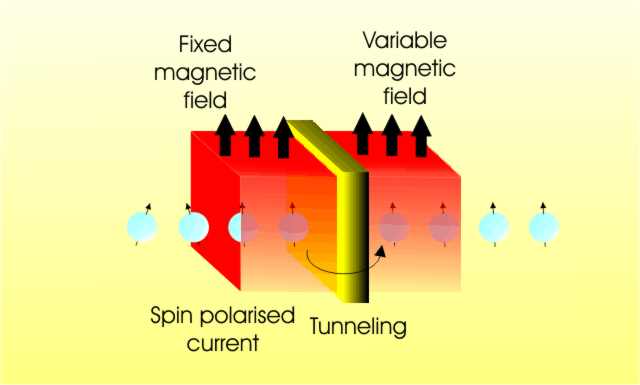| Spintronics |
| Written by Editor | |||||
| Sunday, 30 August 2009 | |||||
Page 3 of 4
MRAMAn even more impressive use of spintronics is that MRAM – Magnetic RAM. You can think of this as the integrated circuit equivalent of the old magnetic core memories if you want to but it is another example of the three-layer spin valve principle. There are a number of ways of implementing MRAM but the magnetic tunnel junction (MTJ) seems to be the current firm favourite. The magnetic tunnel junction uses the same three-layer sandwich of magnetic-nonmagnetic-magnetic material but with a number of minor differences. The first is that the nonmagnetic insulating layer is very thin. The second is that the first layer is pinned but the second layer can be changed by passing a small current through it. The electrons get through the thin insulating layer by a process known as “tunnelling”. This is a quantum effect that shouldn’t happen according to classical physics. Because quantum mechanics deals with probabilities of things happening there is often a non-zero probability of something happening that is forbidden by classical mechanics. In this case classical mechanics says that there is no way that an electron can get through the insulating layer – it physically doesn’t have the energy needed to break through. Quantum mechanics, on the other hand, says that there is a small probability of the electron just appearing on the other side of the barrier without having to worry about how it got there! In picturesque language it is said to have “tunnelled” though the barrier rather than going over it. You can get very worried by such ideas but tunnelling does happen and there is a small current flow as a result. The key thing about tunnelling is that it is very sensitive to the conditions. If the insulating layer is very thin then there will be a lot of tunnelling current – slightly thicker and there will be very little. When the pinned layer is in the same direction as the changeable layer the tunnelling current is high. The electrons in the pinned layer have the right spin to pass into the changeable layer. When the changeable layer is magnetised in the opposite direction the electrons have the wrong spin to exist in there and the tunnelling current goes down by a factor of 1000. By simply flipping the magnetisation of the changeable layer you can store a 1 or a 0 and read the data by the resistance of the MTJ.
Currently MTJ based MRAM is being developed by IBM and Infineon and the first devices are available as storage cards for PDAs and mobile phones. The huge advantage of MRAM is that it stores the data even when the power is off. This makes it possible to save battery power in mobile devices and this is the reason why MRAM is making its first appearance in these markets. The advantages of a non-volatile high speed and high capacity device, however, are such that you can expect MRAM to replace standard computer memory, and perhaps even hard disks, in time. Currently MRAMs have been built which are six times faster than DRAM, which is the type of RAM used for the Megabytes of RAM in most PCs and almost as fast as SRAM, which is used for cache and other high speed applications. If all the DRAM in a PC were replaced by MRAM it would be faster and, operating systems bugs aside, you would never have to reboot. The reason is simply that when you switched the machine on the memory would be exactly as you left it and ready to do useful work. An MRAM chip made by IBM |
|||||
| Last Updated ( Sunday, 30 August 2009 ) |



